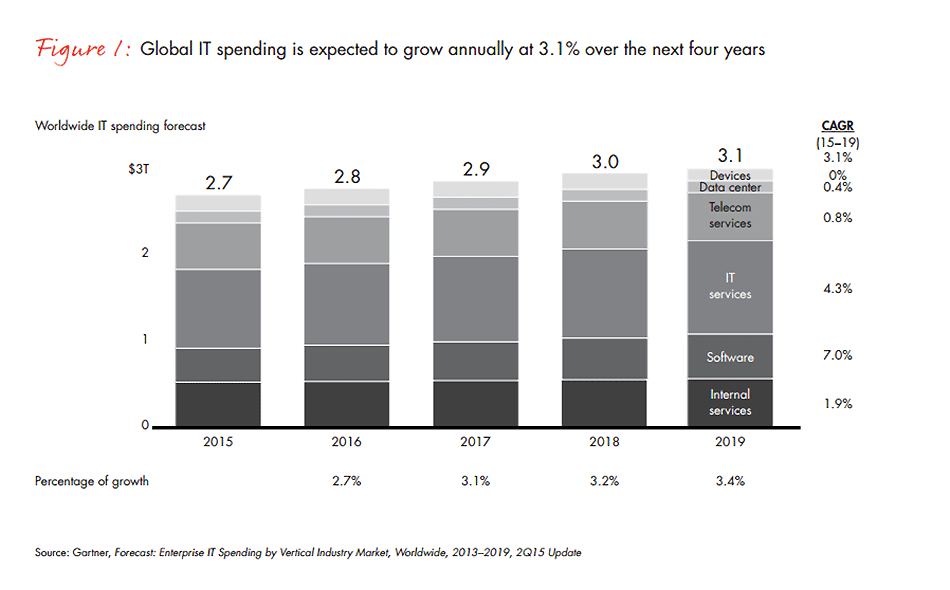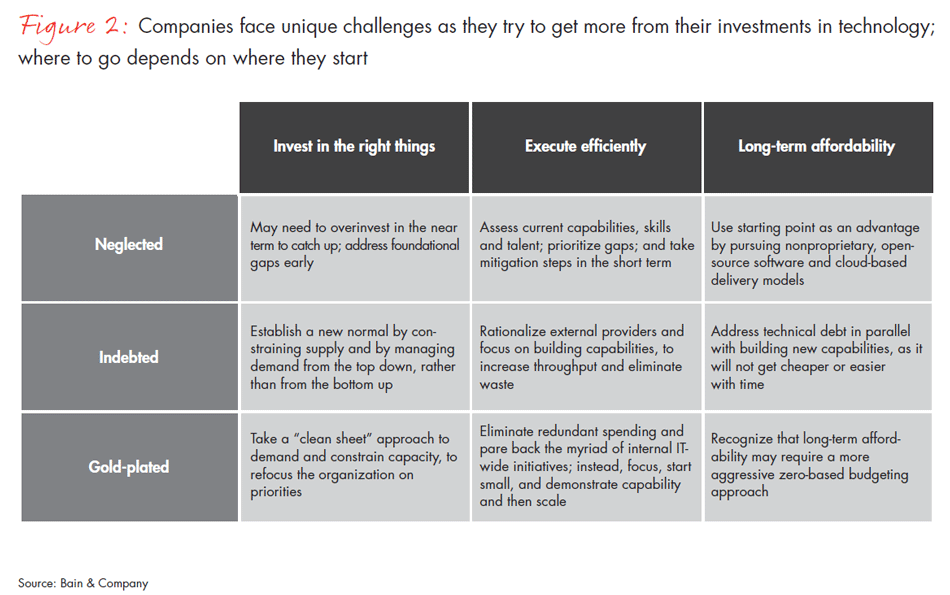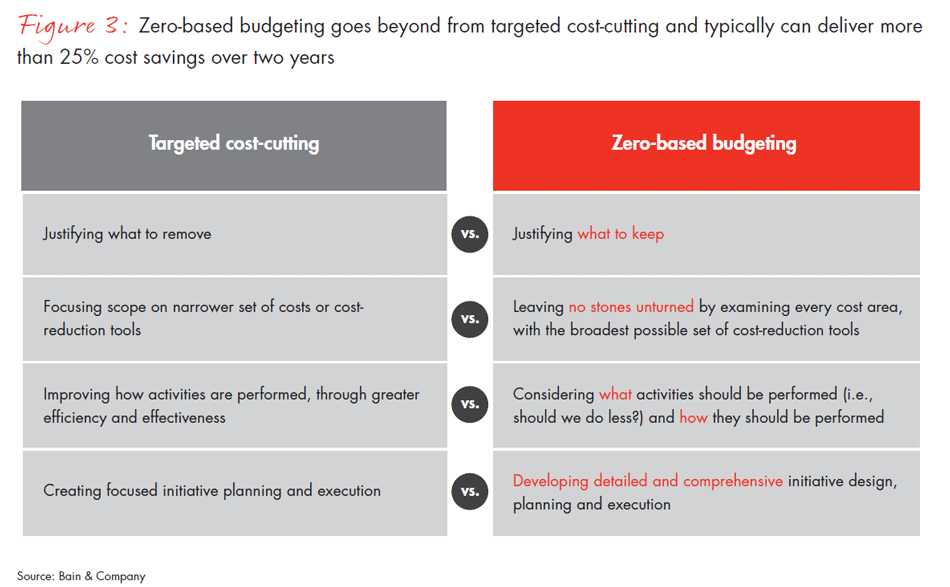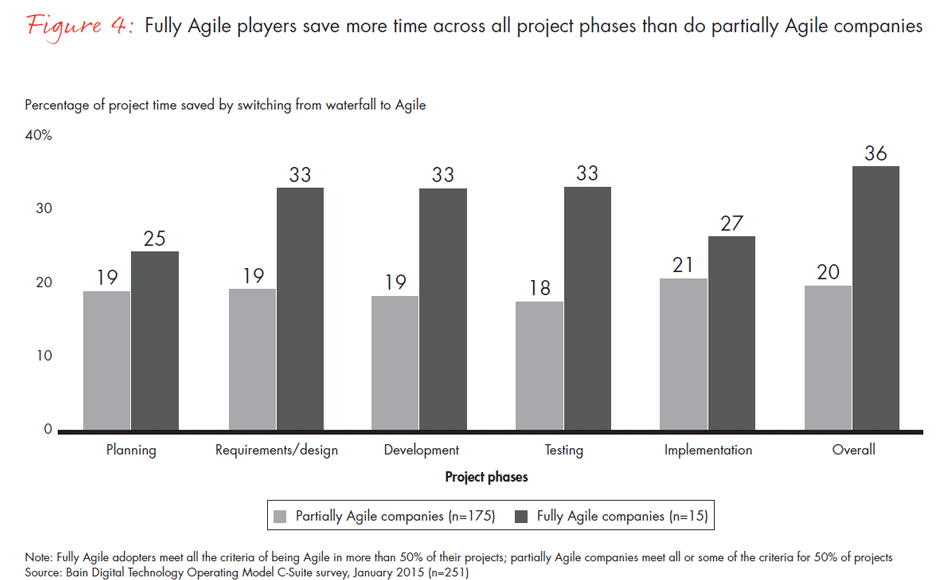Etude

All happy families are alike; each unhappy family is unhappy in its own way.
—Leo Tolstoy, Anna Karenina
Like Tolstoy’s unhappy families, every company’s technology situation is unique—the result of the people, attitudes and decisions that have governed their investments in IT. But in spite of their differences, most companies have this in common: No matter how much they spend on technology, executives are often disappointed with the results. This is an unsustainable tension. Technology plays an increasingly strategic role across industries. Global technology spending is expected to total $2.7 trillion in 2015 and to grow at 3.1% over the next five years (see Figure 1). In many companies, IT is the single biggest contributor to general and administrative costs.
Given technology’s prominence, senior executives’ disappointment with results and their frequent alarm at the rise in technology spending, IT leaders are under intense pressure to deliver. This is particularly true for companies embarking on broad digital transformations and for whom aggressive cost management represents the most effective and efficient way to self-fund the expansion of their digital capabilities. (For more on digital transformation, read the Bain Brief “Rebooting IT: What separates digital leaders from the rest.”)

How companies achieve cost savings and long-term sustainability depends on their starting point. And despite the observation that every IT group is unique, in our work with clients across industries and regions, we find that most IT organizations fall into one of three types: neglected, indebted or gold-plated.
Neglected. Some companies spend only enough on technology to maintain current operations and fix problems, particularly in industries where executives see technology as little more than a cost center and not a strategic enabler. We worked with an oil and gas company that had grown rapidly while making only limited investments in technology for basic operational needs. When the company acquired a business almost twice its size, it found that its existing systems and infrastructure would not scale up to support growth expectations and capture the anticipated synergies. The technology staff was stretched thin, large capabilities gaps were appearing and IT leadership wasn’t up to the task of making difficult decisions about trade-offs. The challenge for this company and others we have worked with was determining where to prioritize investment.
Indebted. In industries where technology has suddenly become much more important, historically underfunded IT organizations may suddenly face big upticks in demand. They often struggle to keep up with the needs of the business and depend heavily on external contractors to bridge the gap between demand and internal capacity and capabilities. Today this is most prevalent among retailers, because of the rapid change brought on by a range of disruptive technologies, including online shopping, and the need to deliver an omnichannel experience for customers. Demand for technology far exceeds their internal capabilities and resources.
We worked with a large national retailer that relied heavily on external providers to meet its rising demand for technology. External providers helped it address its urgent needs, but overreliance on contractors, in lieu of hiring new talent and building up expertise, caused it to fall behind in its capabilities. And this talent gap grew: As the in-house technology teams fell further behind, it became more difficult to hire top talent. The complexity of managing this labor pool, coupled with mounting technical debt, greatly reduced the efficiency of every dollar spent on technology.
Gold-plated. While this seems like a problem many CIOs would be glad to have, the truth is that poor governance and a failure to prioritize have led these IT organizations to overinvest in the wrong things, often chasing the new idea of the moment or failing to rationalize redundant systems and infrastructure. Gold-plated IT organizations often suffer from unnecessary complexity caused by custom-made solutions that may or may not offer competitive advantages. These organizations suffer not only from unchecked business demand, but also from too many IT initiatives around the latest certifications, movements and tools.
For example, a telecom provider was funding more than a dozen different billing systems, because each business unit wanted a bespoke system to meet its specific needs. This kept costs high and, more important, made it harder for the company to invest in new functionality that it needed to integrate customer data and interfaces across the various services it offered.
Will Poindexter, a partner in Bain's Information Technology practice, looks at how to identify your company's IT archetype, and what to do next.
Three things to get right
These three archetypes can be helpful as IT leaders think about their starting point, guiding where to focus their efforts in managing technology spending. Regardless of the starting point, IT leaders should ask three salient questions (see Figure 2):

Are we investing in the right things? What are our business priorities and their implications for technology? What market dynamics influence our technology priorities and demand for technology?
Are we effectively executing on our investments? Are our organizational capabilities and talent operating with the speed and agility required to enable and innovate business capabilities?
Are our investments affordable? Are we spending appropriately and managing the balance between new investments and existing assets? Or, have we underinvested and created technical debt that will affect the company’s long-term health?
Invest in the right things. It’s surprising how many companies don’t really understand what drives their technology costs. Too many executives simply look at the cost—what’s being bought (hardware, software, other resources) or who is buying (business unit, function, region)—when they should focus on the value of what they are buying. Whether it’s topline growth, keeping the lights on or complying with regulations, demand for resources will always outpace supply, so executives need to make their spending as effective as possible.
Gold-plated organizations may have the hardest task as they tighten their discretionary budgets and basic operations. Leaders will need to place limits on contractors and suppliers, which may have run unchecked. Departments accustomed to feeding their own demands may need reining in by senior executives who can prioritize the top two or three companywide initiatives, then allocate budgets to lower levels, where teams can spend with some autonomy—and ample accountability. Some organizations may require a more aggressive zero-based budgeting approach, starting with a blank sheet and building a budget based on strategic goals (see Figure 3). This process yields good results, but managers have to balance those against potential disruption. (For more, read the Bain Brief “Radical redesign through zero-based budgeting.”)

Companies that have neglected IT may need to overspend for a while to bring their technology capabilities up to par as they put governance in place to balance new investment in basic infrastructure and services with investment in new business capabilities.
Execute effectively. Perhaps the most significant IT investment is improving the organization’s capabilities, which can boost efficiency (doing more with less) and effectiveness (doing more better). Shifting to Agile development, for example, can yield savings of 20% to 35%, by removing unnecessary work and overhead, and companies that are fully Agile save more time than those that are only partially committed (see Figure 4). Agile focuses the team on delivering shippable code in one- to four-week sprints. Agile removes barriers between business decision makers and engineering teams, focusing both on outcomes rather than on project milestones.

Another way to improve effectiveness is to look closely at outsourcing, which has delivered mixed success at most companies. Most IT organizations still are not very good at working with external partners, particularly when they are many time zones away.
Nowhere is the need to improve effectiveness more prevalent than with technically indebted IT organizations. As we mentioned earlier, most were unprepared for the rapid spike in demand and turned to external contractors to supplement their capabilities and their capacity, but didn’t build the skills to manage vendors and a large contingent workforce. With the organization primarily focused on enabling new business capabilities, there was little capacity to address technical debt, and thus it continued to mount. For example, we worked with a financial services company that was spending $200 million annually on technology and falling further into technical debt. The company had outdated infrastructure and was spending too much on contractors. Its technology costs were growing twice as fast as revenue, and it still couldn’t meet its business needs.
The company’s technology leaders engaged senior management, and together they formed a plan to modernize their infrastructure and streamline their sourcing model. They drew business executives into the governance process and reduced their list of vendors to just a few having a managed services model. Combined, these measures helped bring technology spending in line with revenue growth and deliver more effectively on business commitments.
Many of these same principles apply to gold-plated organizations, which have grown unchecked and failed to manage demand. One way to root out inefficiency and bloat is to track a set of everyday activities through the organization: How is a new environment provisioned, or how does application security handle access management? For most organizations, there should be no more than four levels between the CIO and employees punching the keys.
In IT organizations that have not kept pace, the problem can be more nuanced and challenging. Underinvestment may have left the organization with stale talent and atrophied capabilities. A good first step is to take an inventory of capabilities to uncover strengths and weaknesses. Those findings can help executives prioritize areas for investment, which usually include a new and talented leadership team. From there, hiring and development should be focused on critical capabilities that are linked to business priorities. For example, retailers building an omnichannel experience would want to fill digital roles first, then build outward.
Achieve long-term affordability. Most companies struggle to balance new investments and the building of fundamental capabilities. Many rely on benchmarks to gauge their spending against that of comparable organizations, but metrics are only one tool, and executives need to be aware of their limitations (see the sidebar, “Lies, statistics and benchmarks”).
In gold-plated technology organizations, poor demand management often results in expensive tools and technologies that are seldom if ever used. Rationalizing the portfolio can help create a more effective function without a noticeable decrease in capabilities. We worked with a global financial services company that had multiple development environments, created by individual technology development teams and based on historical preferences. Several of these were overconfigured, with expensive software licenses and infrastructure designed for peak usage (which were never really utilized), leading to high costs and complexity. The company moved to a cloud-based delivery model and reduced the number of environments, saving up to 15% on development costs.
Poor architecture, combined with technical debt, raises the costs of operations and new development. For most companies, the answer cannot be to replace every legacy system, so these organizations must be prepared to live with the mainframe for years to come. Instead, the solution lies in protecting some portion of discretionary spending for long-term housekeeping and the evolution of architecture, and not allowing the urgent impulse to build something quickly to overshadow the need to build it correctly. Every IT organization should investigate the potential of nonproprietary, open-source software as well as cloud computing, but this is probably most important for IT organizations that have been neglected.
Understanding the answers to these three questions can help identify a clear starting point for action. At the oil and gas company mentioned earlier, the senior management team’s plan to bring the company’s technology capabilities up to speed began with a clear decision to increase investments and to hire a CIO with experience managing larger technology groups. The team then developed and launched plans to triage immediate gaps in capabilities while making investments in new systems and infrastructure, and building up internal talent over the long term. The plan depended on a partnership with a third-party provider to augment their capabilities during the transition, which helped the company begin delivering some of the promised synergies while putting its longer-term plan into effect.
For the technically indebted retailer, IT leaders reduced the number of external contractors, to intentionally constrain capacity while working with executives from the business to rationalize discretionary demand. In parallel, the entire organization moved to a new operating model built around Agile and DevOps principles. This increased throughput, minimized handoffs and aligned business and technology staff on business outcomes. Additionally, the team undertook a multiyear journey to modernize technology with a renewed focus on architecture.
Finally, at the gold-plated telecom provider, senior managers started bringing spending under control by launching a multiyear program to consolidate the company’s many billing systems—which, on close inspection, didn’t differ very much from one another. Business unit and technology leaders collaborated to decide how to rationalize the systems. As a result, the telecom
- reduced the cost of billing operations and system support by 20%;
- saved 10% to 15% on the cost of new business projects;
- improved call center performance and reduced training costs, since everyone could focus on a common billing system.
Regardless of a company’s starting point, there are some basic guiding principles that business and technology leaders should recognize and agree on before plotting a path forward.

Fixing IT: Solutions for Every Organization
How to identify what type of IT you have and three key questions to answer.
Do no harm. Short-term cost pressures often force companies into decisions that yield only marginal savings while damaging long-term capabilities: cutting technology budgets, delaying upgrades and replacements, or waiting on strategic investments in organizational talent and capabilities. More efficient ways to reduce short-term costs without harming long-term prospects include rationalizing demand, seeking concessions from suppliers, and limiting work by contractors and other external support. Focusing on these opportunities while protecting top business priorities ensures a healthier and more stable IT function.
Take measured risks. Excessive caution can be expensive if risk-averse leaders overinvest in unnecessarily high service-level agreements and premium maintenance and support contracts. Paying for five nines can be a good investment in some places; in others where stable technologies suffer few incidents, it can be an unnecessary luxury. A risk-based approach to tiered service and support levels, based on business criticality and compliance requirements, can deliver better value for recurring maintenance and support fees.
Establish accountability for results. Accountability is critical for managing costs, and it’s important to ensure that the incentives for technology and business staff complement each other. It can be counterproductive to have IT focus on metrics that are not value oriented, such as time and budget, while the business focuses on growing sales and reducing customer churn. Instead, teams need to have shared accountability for what matters most—business results.
Lies, statistics and benchmarks
Many executives misunderstand benchmarks, often misusing them to bolster weak arguments. Benchmarks are directional at best and wildly misleading at worst, because they measure inputs, not results—a weakness underscored by our findings. For example, as a percentage of revenue, digital leaders spend about the same on these metrics as laggards do. Nowhere is the relationship between benchmarks and actual results more tenuous than with the ubiquitous “IT spending as a percentage of revenue” benchmark. Its application presents a range of problems:
- capturing the full cost of technology, not just the IT function’s tracked budget;
- accounting for the “lumpiness” of technology expenses on a cash basis when expenses might vary significantly from one year to the next;
- understanding differences in technology platforms and complexity, especially if the company has a history of acquisitions;
- adjusting for investment patterns in capabilities; and
- equating relative size of companies and economies of scale.
In our experience, benchmarks based on IT spending as a percentage of revenue become less relevant at the low and high ends of the spectrum. Further complicating things, revenue depends on a range of factors beyond IT’s control, including market dynamics. It’s difficult to reduce IT spending quickly if revenue drops—though companies are better at raising it quickly, as retailers have done over the past five years. This has left many CFOs of retailers pushing for IT cost reductions, using historical benchmarks as ammunition.
Benchmarks are not completely useless, but executives should follow a few basic principles to get the most value from them.
- The best benchmarks are internal. Benchmarking performance across internal organizations, including separate business units, regions or portfolios, makes it easier to achieve like-for-like comparisons, understand differences and gauge potential.
- Focus on value. Emphasize the business value derived from technology spending and determine how effective the organization is at extracting it. Companies investing in new capabilities and reducing their technical debt may spend more than competitors—but they may be getting good value from it.
- Real insight lies below headline numbers. IT spending as a percentage of revenue may be a dubious metric, but measuring running costs against growing costs, as well as specific practices around offshoring, outsourcing and technology adoption, can be very instructive.
- Shift from benchmarks to action and feedback loops. Benchmarks are static and hard to translate into action. Instead, understand what drives performance and establish a feedback loop to help reinforce an Agile mindset.
Vishy Padmanabhan is a partner with Bain & Company in New York, and Will Poindexter is a partner in Chicago. They work with the firm’s Global IT practice.



